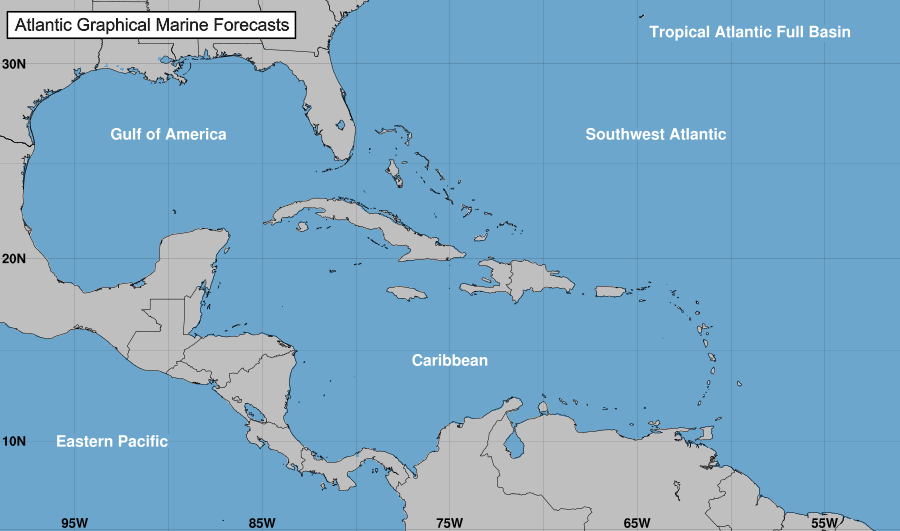Current Weather
National Forecast

Hurricane Forecast



What is a Hurricane?
Tropical Depressions, Tropical Storms, and Hurricanes are all Tropical Cyclones. They can be over 1200 miles in diameter. Tropical Cyclones are storms driven by energy from warm ocean water. Water absorbs heat (energy) from the sun and evaporates. The high energy water molecules carry that energy as they rise into the atmosphere. Cold air in the atmosphere forces the water molecule to release some energy and condense into a droplet, forming the clouds of very tall thunderstorms. As each water molecule releases energy, it pushes on other molecules, causing them to move.
Tropical Cyclones rotate about a center due to the conservation of angular momentum of the Earth’s rotation. The arms or bands of a hurricane seen in satellite images are moving to the center of the storm.
Hurricanes begin life as a tropical depression with sustained winds less than 39 mph. As they become better organized and the wind increases above 38 mph, it becomes a tropical storm. Once it reaches 74 mph, it is a hurricane. Hurricanes with sustained winds over 110 mph are major hurricanes.
Browse by Type
-
Standby Generators
- Air Cooled
- Liquid Cooled
- Natural Gas
- LP Propane
- Diesel Generator
- Generac Home Generators
- Whole House Generators
- 6kW Generator 7kW Generator
- California Generator CARB Compliant
- Solar and Off Grid Backup
- 8kW Generator
- 10kW Generator
- 11kW Generator & 12kW Generator
- 13kW Generators
- 14kW Generator & 15kW Generators
- 16kW to 17kW Generators
- 18kW Generator
- 20kW Generator
- 22kW Standby Generator
- 24kW Generator - 26kW Generator
- Power Management Generator
- Small Home Generators
-
Commercial Generators
- 10kW to 19kW Commercial Generators
- 20kW to 29kW Commercial Generators
- 30kW to 39kW Commercial Generators
- 40kW to 49kW Commercial Generators
- 50kW to 59kW Commercial Generators
- 60kW to 69kW Commercial Generators
- 70kW to 79kW Commercial Generators
- 80kW to 99kW Commercial Generators
- 100kW to 150kW Commercial Generators
- Commercial Natural Gas Generators
- LP Propane Commercial Generators
- Agricultural Generator - Farm Generator
- Diesel Generators
- 240V Single Phase Generators
- 208V 3 Phase Generators
- 240V 3 Phase Generators
- 480V 3 Phase Generators
- Aluminum Enclosure Generators
- Steel Enclosure Generators
- Carb Compliant Generators
- 22-48kW Aluminum Enclosure
- Steel Enclosure 25-45kW
-
Portable Generators
- Inverter Generators
- Home Backup
- Dual Fuel Generators
- Propane Generators & LP Generators
- Quiet Generator
- Small Generators
- California Carb Compliant Generators
- Remote Start Start Generators
- Portable Generator for Camping
- Portable Power Stations
- Tailgate Generators
- 15000-20000 Watt Portables
- 12000 Watt
- 10000 Watt
- 8000 Watt
- 7000 Watt
- 5000 Watt
- 2000 Watt
- 3000 Watt
- Electric Start
- Gasoline
- Emergency
- Recreational
- Tri Fuel Generator
- Contractor Generator
- Diesel
- Diesel Generators
- Home Generators
- RV Generators
- Commercial Mobile Generators
- Prime Power
-
Generator Transfer Switch
- 50 Amp Transfer Switch
- 100 Amp Transfer Switch
- 150 Amp Transfer Switch
- 200 Amp Transfer Switch
- 300 Amp Transfer Switch
- 400 Amp Transfer Switch
- 600 800 Amp Transfer Switch
- Indoor NEMA 1 Transfer Switch
- Transfer Switch Power Management
- Outdoor NEMA 3R Transfer Switch
- 240V Single Phase Transfer Switch
- 208V 3 Phase Transfer Switch
- 240V 3 Phase Transfer Switch
- 480V 3-Phase Transfer Switch
- Automatic Transfer Switches
- Manual Transfer Switches
- Generator Maintenance Kits
- Solar Power
- Generator Power Cords
- Generator Accessories
- Generator Replacement Parts
- Water Pumps
- Outdoor Power Equipment
- Clearance
- Quiet Generators
